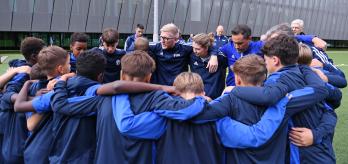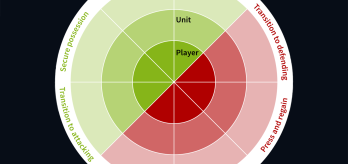As anyone who has ever seen a photograph of an U15 squad will tell you, no two children develop at the same rate. The temporary physical discrepancy between "early" and "late" developers can have major repercussions for young players, with late developers frequently overlooked in favour of bigger, stronger (but not necessarily better) early-developing team-mates. In this fascinating session, Professor Sean Cumming from the University of Bath explains the physiological impact of adolescence on young bodies, and considers how coaches can make sure all their players get the chance to shine. His presentation is followed by a Q&A session hosted by FIFA's Dr Paul Bradley.
Explain what happens to children's bodies as they grow, and the implications of this development for coaches. Show how natural variation in the timing of maturity can give rise to player selection biases. Suggest how these biases might be addressed in academies and youth teams.
Variations in the timing of maturity significantly affect performance and selection in football academies.
Coaches need to be mindful of these effects and consider how they can adapt competition and practice to guard against biases, injuries, and other associated impacts.
Watch video
Read summary
Part 1: Growth in childhood and adolescence
The first step towards understanding the way young athletes mature is to study growth in childhood and adolescence. In the first section of his presentation, Professor Cumming explains that while growth is generally steady and predictable in both boys and girls during childhood, puberty sees major growth spurts in height and weight, accompanied by significant physiological changes that can leave young athletes more vulnerable to injuries. With that in mind, it is very important for coaches to be aware of the "adolescent growth spurt" and modify training accordingly.
Part 2: The adolescent growth spurt
Given the importance of the pubertal growth spurt, it is worth exploring it in more depth. In the next part of the session, Professor Cumming outlines the specific challenges associated with puberty in young athletes. These challenges are compounded by the fact that children go through puberty at different ages, meaning that two players playing in the same age group can demonstrate marked differences in size, athleticism, and physiology. These variations can have enormous repercussions for both talent identification and development.
Part 3: Maturity timing and selection biases
Particularly in boys, individual differences in the timing of maturation can often give rise to selection biases. From the onset of puberty, early developers tend to be bigger, stronger, faster and more powerful than late developers of the same age, making them more likely to be selected for age-group teams. Indeed, studies suggest that perhaps 60-80% of all U16-U17 academy players are early developers, prompting concerns that many players are retained in the academy system because they are physically superior to their peers, not because they are better footballers.
Part 4: Concerns for youth development and how to address them
In the final section of the presentation, Professor Cumming considers how academies can counteract this bias and mitigate the risk of losing a great talent who happens to be a late developer. As Sir Alex Ferguson was well aware, keeping late developers in the system and giving them time to flourish can bring enormous rewards. By contrast, writing off a late developer can prove costly, as Arsenal found out after they released a young striker by the name of Harry Kane.
Q&A
01:09
We live in a multi-cultural society. Are there any differences in maturation across ethnic groups?
03:33
Why does the timing of maturation have less of an impact on player selection for girls as opposed to boys?
05:38
As scientists, we think methodology is important. What are the best methods for measuring growth and maturation in athletes?
09:53
How often should we be measuring girls and boys to assess maturation? Can you give us some best-practice examples?
12:17
We've already had a great session on the relative age effect (RAE). Are maturation selection biases inextricably linked to RAE, or are they different?
16:23
There seems to be a lot of scientific work in this area, particularly on physical development. Has anything been done on the emotional and psychological maturation of young athletes?
19:51
I also wanted to ask you about the exponential development of the nervous system. Can you provide a bit more context about that?
22:55
You mentioned various physical measures of maturation, but do skill development and game intelligence follow a similar curve?
25:44
If you were to give practitioners one piece of advice on this area, what would it be?



















